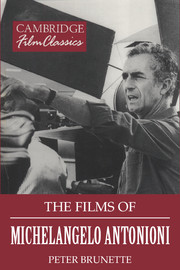6 - The Passenger (1975)
Published online by Cambridge University Press: 05 June 2012
Summary
The opening shot of The Passenger is full of whites and grays and muted earth tones, and it provides a clear indication of what is visually to come. The bright primary colors of Red Desert and Blow-up have now been evacuated, and the ebony bodies of the African men contrast sharply with their shining white clothes, reducing the world to a visual Manicheanism. This whiteness spreads in all directions, like spilled paint, combining with the dull, unemphatic earth colors to produce an insistent blankness that pervades the film and is echoed in the desert, the various washed-out Spanish towns the principal characters travel through, and the sea. The film is a blank canvas on which identities will be projected, explored, and refashioned. Thus much of the landscape, for once, is there only negatively; an unmarked sheet of paper, it is a palimpsest on which to write the self. The implacable silences of the sound track contribute hugely to this sense of blankness, silences that are paradoxically heightened throughout by scraps of unknown languages, the faint cries of children playing, and faraway musical instruments that we will never see.
This blankness goes beyond the merely visual and aural. Antonioni has said that what attracted him to Africa was something else: “More than the desert in and of itself, I always felt the need to live in a different historical context, in a nonhistorical world, or in a historical context that is not conscious of its own historicity.”
- Type
- Chapter
- Information
- The Films of Michelangelo Antonioni , pp. 127 - 146Publisher: Cambridge University PressPrint publication year: 1998



